


The talk, maps and data used in this report is available on the AZ_PROJ web site at http://www.wm7d.net/azproj.shtml.


other logs to be processed KB0CJ, VE3CDP

I had been using the AZ_PROJ software for the Most Wanted Grid project in Europe, an annual count of the most wanted grids, which is used to plan the next year's dx-peditions, rover routes and contest sites.
In order that we could have similar information in North America, I volunteered with our employees at the ARRL to analyse the 50yrs or so contest logs and award records that we've paid them to collect on our behalf. The League is a big proponent of being able to justify to the public (and its representatives in congress) that hams are making good use of our bandwidth and that we are are expanding into the higher frequencies. The information that our employees have collected for us covers many sunspot cycles and goes back to the days when 2m was cutting edge for hams and equipment was largely home built. Contained in these logs is information about propagation, good and bad locations and lessons learned by those who did well in these events. This would show us how to increase our number and distance of contacts, particularly on the difficult higher bands. I expect that analysing these logs would increase our enjoyment of ham radio and more people would operate on VHF.
Rather than being heartened by my interest in helping ham radio, the ARRL spent 6 months stonewalling me and accused me of doing it for self interest to increase my score in contests. I found this about ARRL contests
The grip of the ARRL contest winners on their position is sufficiently tenuous that even the logs from 10yrs ago are not available. Presumably the ARRL thinks the less skilled operators would be able to threaten the best operators using 10yr old information.
With these attitudes toward potential volunteers and the skill level of hams, the ARRL is looking to recruit new members from amongst young people. The ARRL has little understanding of the barriers to entry to ham radio for young people and the problems of participation by young people who are already hams.
Previously I'd asked to include information from the ARRL's repeater directory in the AZ_PROJ website maps. The ARRL refused saying that giving us the information we'd paid them to collect would decrease the income from publishing the directory.
At the same time, the League presented fait accompli, in QST, their plans for restucturing ham radio to increase the League's membership. No consultation with members like myself was involved. In the month before that issue of QST arrived in our homes, Hugh Turnbull W3ABC, the League's lobbyist in DC, talked to a club in Baltimore declaring that "restructuring was dead". This was presumably after the text of QST committing the ARRL to restructing, was in print. No 50yr plan for ham radio was presented by the ARRL as part of their restructuring and none of the factors that had contributed to the decline in League membership was analysed to look for the cause. None of the umbrella radio organisations in other countries, that are the basis for the all important international friendships formed in amateur radio, had been consulted to see if this trend was a world wide or local phenomenon.
I wrote a 50yr plan for ham radio, addressing these problems, to K1ZZ who I've known personally for the last 10yrs. I'd always thought of ham radio as a cooperative self educating, hobby and since the late '50's had looked to the ARRL as one of the protectors of ham radio. K1ZZ replied that he'd get back to me. He never did. I concluded K1ZZ has no 50yr plan for ham radio, only a plan for stopping the decline in ARRL membership. I dropped my membership. Instead of a 50yr plan for ham radio, I got 3 bulk mailings emblazoned with "you spoke, we listened" exhorting me to join the ARRL in order to save ham radio. (Oct 00: I've just got another one - emblazoned with "We want you back", Jul 02 an olympian "The Dream is Alive").
The tax paying and voting public and the FCC can't have much sympathy for ham radio's requests for bandspace when the ARRL is preventing us from learning from our hobby and has no plan for the future of ham radio. The ARRL, when faced with changes in ham radio initiated by the FCC, will have to roll over and accept them (wringing their hands in dispair), as happened with incentive licensing in the '50's, the multi-layered scheme introduced in the late 80's which at the time the League championed, but now regards as a failure, the loss of the bottom 2MHz of the 220MHz band and the recent restructuring of ham radio. If the FCC determines the fate of ham radio everytime, we don't need the ARRL.
One can imagine the effect on the political clout of the National Rifle Association (NRA) if they were to declare that in order to stop the decline in membership, that they no longer regarded marksmanship and gunhandling as hallmarks of NRA membership and were working to prevent new members from learning these skills from the established members. It's hard to imagine the NRA allowing the dispatch of the lower 2MHz of the 220 band to a delivery company on the pretext that it was the only possible way to keep the company functioning, only to have the company turn around and resell the bandspace for its market value.
Looking elsewhere, I offered to analyse the VHF Sprints, a contest had been abandonned with short notice by the ARRL. The Sprint organisers wanted to learn from their efforts and I produced the following map from 390 QSOs on 2m. I've added elevation data at 5min resolution, good enough for 2m but not good enough for 10GHz. It was a link to this map that I sent out with the requests for logs.
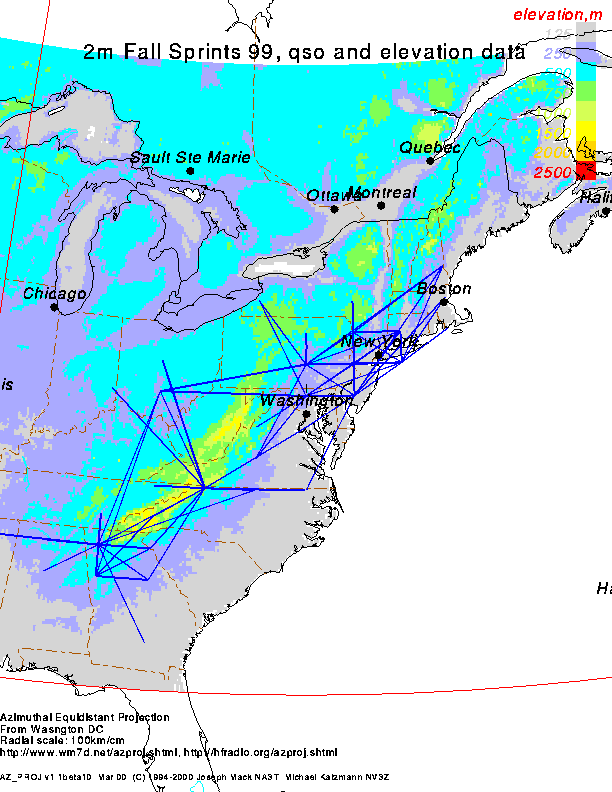
This analysis of the auroral opening of 15-16Jul2000 is my attempt to show that logs of contests and openings should be routinely analysed.

Auroras are caused by energetic particles ejected by the sun striking the earth's atmosphere. The energy and number of these particles depends on the phase of the solar sunspot cycle. We're approaching the peak of solar activity for this sunspot cycle. Here's the predictions for the rest of cycle 23.
Visible AU goes to 400km altitude (F-layer).
The aurora required for VHF propagation
needs large densities of electrons lower in the E-layer than this, at 110km.
The geometry of an aurora contact (reflecting layer at 110km
of which you can only see an ellipse of 1200km E-W and 600km N-S) limits
the longest AU contact to 2175km (unless you're on a mountain top).
Your ability to see an aurora depends on the intensity
of the aurora and very sharply on your geomagnetic latitude.
At a geomagnetic latitude of 66deg, you see aurora even if there isn't a storm.
At a geomagnetic latitude of 48deg you need the highest level storms to see aurora.
Comparison of Auroral Boundaries from Kp and
Auroral Activity Level at Local Midnight
Magnetic Latitude
Kp Magnetic Latitude NOAA POES Auroral Activity Level
66.5
64.5
62.4
60.4
58.3
56.3
54.2
52.2
50.1
48.1
The north magnetic pole is offset from the geographic north pole.
It's in eastern Canada.
One consequence of for hams in eastern USA is that we are 10deg closer
to the magnetic pole than indicated by geographic latitude.
Here's a map showing the Kp index needed to see an aurora.
Not only is NE USA VHF alley, but it's also aurora alley.
In the western states of USA, the Kp-index has to be 2-4 units higher
at the same geographic latitude, to see aurora.
As will be seen in the maps later, the QSOs for the opening
of 15-16Jul follow the sweep of the Kp iso-lines for 7<Kp<9.
The location of the Geomagnetic North Pole has other consequences
as I found recently at a conference in Ottawa (Canada).
Apparently it's hard to find your way using a magnetic compass in Canada
due to the high dip angle.
One of the better known makers of compasses in Canada
is a company called "Taits".
The problem of finding your direction with a
Taits compass apparently is the origin of the expression
"He who has a Taits is lost."
One table is worth 1000 images, so here's a table of
the geomagnetic latitude for some world cities.
Europe and Asia
Southern Hemisphere City Magnetic
Latitude* City Magnetic
Latitude* City Magnetic
Latitude* 44.5 31.3 45.9 51.7 48.3 23.3 52.2 51.9 41.5
42.7
53.0 49.9 48.3 47.5 32.1 54.9 33.3 23.2 34.1 51.8 Dunedin 53.0 39.8 44.2 38.8 29.1 53.8 41.1 55.1 45.5 Hobart 53.6 50.6 35.5 48.4 56.2 56.1 43.9
42.5 46.7 38.6 52.7 34.1 43.5 49.2 47.0 53.9 31.0 49.1 29.0 59.5 36.5
On thurs 6 Apr 2000 (near a new moon) after the usual internet alerts
(which sounded like every other aurora alert of the last few years,
none of which had produced any visible aurora),
I came home from (ironically) a PVRC meeting,
did my usual stuff, didn't bother turning on the computer, which would have
alerted me to the aurora visible outside my front door in
North Carolina (NC), put my son to bed and
went to bed about 9pm (I get up at 4:30am).
All the other people in NC sitting in their
back gardens with their house lights off, saw courtesy of
a moonless night, and a clear sky
(it's usually hazy in NC),
the first aurora in NC in most people's memory.
Here's the Kp predictions for 6 Apr 2000.
The units and colors used in these images need no explanation
(the SEC doesn't think so), so the important part presumably
for aurora propagation is the red bars (red alert) in the "Estimated Kp" box.
About 12 Jul 2000, another solar flare warning appeared and
by saturday afternoon 15 Jul 2000, hams were reporting good tropo,
amateur astronomers watching for visible aurora were seeing
it as far north as Melbourne,
Australia (which was in darkness at the time)
- an event that only occurs once or twice in a lifetime.
(A later report was received of visible aurora in the mountains west of Sydney, Australia).
The best visual aurora was seen in NE Russia (presumably due to time/sunlight).
The report from "Solar Terrestrial Depatch" posted by Shelby Ennis W8WN
was of an S4 event (on scale 1-5) that was not as strong as the event of Mar 1989,
but was at a level only statistically expected 3 times in an 11yr cycle.
This time I was on the computer (being a saturday and being at home)
and knew what was happening. Unfortunately it was raining at the time and
even if the weather had been clear, the full moon would have precluded seeing any
but the strongest aurora. Not only was the tropo good before the opening, but
continued afterwards for at least 24hrs with people getting 3000km contacts on 6m
(see
Soapbox
).
The Kp predictions for the 15Jul event were for
a more intense and longer opening than 6 Apr 2000.
Unlike directly copied signals, AU signals are incoherently reflected from the auroral curtain
(the received signal is phase modulated by noise, spreading the signal by 100-1000Hz).
On CW the received signal will not be a tone, but a white noise "psssh psssh".
The phase modulation makes (relatively) wide signals like SSB harder to copy than CW.
The spreading is frequency dependant: On 6m, PH is still easy to copy; on 2m it still can be copied;
but by 220MHz, narrow band methods like CW are the only way to go.
The amount of spreading varies with the auroras.
Some reflect with little spreading (when CW signal have "tone")
while others produce more spreading
(when CW signals sound like "psssh" "psssh" and have "no tone").
Some signals sound like a buzz.
Because of the spreading you can't use a crystal filter, but you still use the b.f.o.
At higher frequencies (>=432MHz), as signals get broader and weaker, the received
CW signal will appear as pumping of the noise floor of your system.
The auroral curtain is moving and will doppler shift the returned signal.
The doppler shift is also frequency dependant: at 6m it's 500-1000Hz, while at 432MHz it's upto 5KHz.
If you are hearing a QSO in progress and you can hear the closest operator direct,
you can zero beat on that signal and when it's your turn, call the distant station by aurora.
If you are replying to a CQ, you don't know how much he's been doppler shifted,
you have to figure out the frequency to reply.
With EME this is easy, the velocity of the moon is known.
With AU you don't know whether to reply lower or higher - you may have to try both.
See below for details of each band.
Here's a site with
aurora audio from this opening (look for the 2m link),
and http://home.sprintmail.com/~mabu/new/Publish/WAV.html, W1FIG's audio files
(look under the Aurora heading) (link dead, Jun 2003).
The auroral curtain is also an irregular, moving, vertical surface.
A QSO can be composed of reflections from several parts of the curtain,
all of which can have different reflecting properties.
By moving your antenna, you may be able to find a reflection that has more
tone on it and will be easier to copy (the frequency may be different for each peak).
Since these reflection points come and go, to complete a QSO,
you need an antenna broad enough (30-40°) to always have a reflecting point in the path.
The narrow beams used in terrestrial or EME contacts are no good here.
4 yagis in a box is too narrow; it would be better to
mount the 4 yagis on a single mast under each other.
High power (>>100W) is needed to continuously
illuminate a large area of curtain with broad antennas,
otherwise you'll loose contact and not complete your QSO.
This problem becomes worse with higher frequency, as power is harder to generate
and the aperature of yagis drops with the square of frequency for constant gain.
The conventional wisdom is that AU has
a threshhold of power, below which you just don't make it.
(Note from NA3T: Some people maintain that all you need in ham radio to have as much fun
as the big boys is 10W clipped onto a coathanger in the closet:
it's not true -
missing out on contacts one after another is discouraging and not fun.
Such advice will make you think that there's something wrong with
you/your skill/your equipment,
since clearly everyone else is getting contacts.
When you go to the houses of these advice givers,
you'll find multiple towers and KW amplifiers.
They tell you to remember that ham radio is a hobby and to not let it
interfere with your job,
your studies and your family,
and then turn around and
write glowing articles in QST about Art Collins (and others),
who made a career out of ham radio,
and teenagers who spent all their time (and probably) money
building contest equipment going on to leave ham radio
and win Nobel prizes in physics.
After hearing all this,
you're ready for the one about winning not being important,
and it's how you play that really counts.
This is true only for you of course.
They have the contest logs and aren't going to let you learn from them.)
So although the received signal may be strong, because of the doppler
shift and the frequency spreading, it may be hard to find.
The aiming point on the curtain is at an altitude of 100km; you don't
especially need high antennas (note from NA3T: although it will help if you want to
hit the curtain 1100km away for maximum path length).
Since the QSO path is via the curtain, you aim at the curtain and not at the other QTH.
As the K-index rises, the curtain moves away from the pole (south in the northern hemisphere).
To contact the same QTH you'll have to move your antennas
away from NE/NW to E-W (this will increase your distance as well).
In circumstances when you can hear the other ham direct,
you can differentiate an aurora with tone from
the direct signal by the direction of the signal.
You usually can't talk through a curtain, so in the unusual situation
of a strong aurora, where the curtain is far south (over the northern
US states), the Canadians can contact each other reflecting
off the north side of the curtain and the Americans can talk to each
other off the south side of the curtain, but the Canadians and Americans
won't be able to talk to each other through the curtain.
Polarisation appears not to matter (at least horizontal works fine).
I don't know if the curtain is specular like Es clouds, where
a horizontally polarised wave is reflected as a horizontal wave.
A vertical curtain doesn't neccessarily equate with vertical
polarisation, which you might expect for the E-W paths, when
the wave will have a low angle of incidence on the curtain.
I'm not aware of any experiments with vertical polarisation.
Unlike EME, where on 432MHz (and higher) your antennas are pointing
at cold sky (e.g. 12°) and masthead mounted low noise pre-amps are essential,
with AU you are pointing at warm ground (300°) and pre-amps are less helpfull.
Still you have to overcome the noise added by warm lossy coax between your antenna
and the receiver and so pre-amps are helpful at 220MHz and above.
6m:
The doppler is 500-1000Hz.
This is within a normal PH bandpass and you can find the signal as if there was no doppler.
Frequency spreading is minimal and PH is workable.
2m:
The doppler is higher.
If you're listening for replies to your CQ, usually they'll be in your receiver passband.
PH is difficult, when there is no tone, but still usable.
You can get several CW contacts in the time taken for a PH contact on an aurora with no tone.
220MHz:
The doppler will shift a reply out of the passband of the receiver.
If you're replying to a CQ, don't reply on the received frequency -
you already know that it will be out of the caller's passband.
You call with 1KHz offset (pick either high or low since you don't know which).
If you're lucky you'll get the right direction.
If they don't come back, try the other direction of offset.
432MHz:
The Kindex needs to be relatively high
(>6 in Maryland, 50°N magnetic latitude) or you'll waste your time.
The doppler shift is about 5KHz.
The receiving person will have to transmit with an offset
and the calling person will have to tune to find replies.
903MHz:
The doppler is about 10KHz.
There's been only 1 AU contact on this band and the signal
sounded like a change in the noise floor of the receiver.
(C) Joseph Mack 2000-2002, Joe NA3T, jmack (at) wm7d (dot) net, http://www.wm7d.net/azproj.shtml
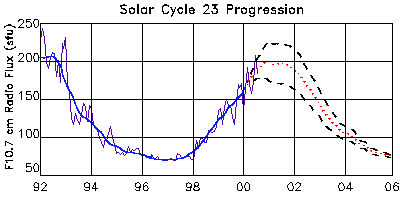
Geomagnetic Latitude and Kp Index required to see an aurora
0
67.5
1
1
66.5
2
2
65.6
3
3
63.9
4
4
62.5
5
5
60.7
6
6
58.6
7
7
56.7
8
8
54.6
9
9
51.0
10
48.5
10+
45.0
10++
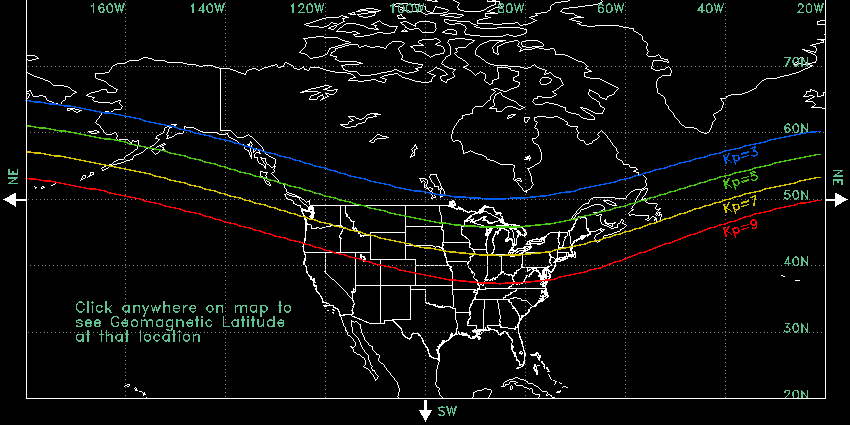
North America
Atlanta
Athens
Adelaide
Boston
Berlin
Buenos Aires, Argentina
Chicago
Copenhagen
Capetown
Dallas
Edinburgh
Christchurch
Denver
London
Comodoro Rivadavia, Arg
Great Falls, MT
Madrid
Concepcion, Chile
Havana
Moscow
Los Angeles
Paris
Durban
Mexico City
Perm
East London
Minneapolis
Prague
New York
Rome
Melbourne
Quebec City
St. Petersburg
Perth
San Francisco
Warsaw
Punta Arenas, Chile
Seattle
Beijing
Sydney
St. Louis
Irkutsk
Toronto
Seoul
Washington, DC
Tokyo
Winnipeg
Vladivostok
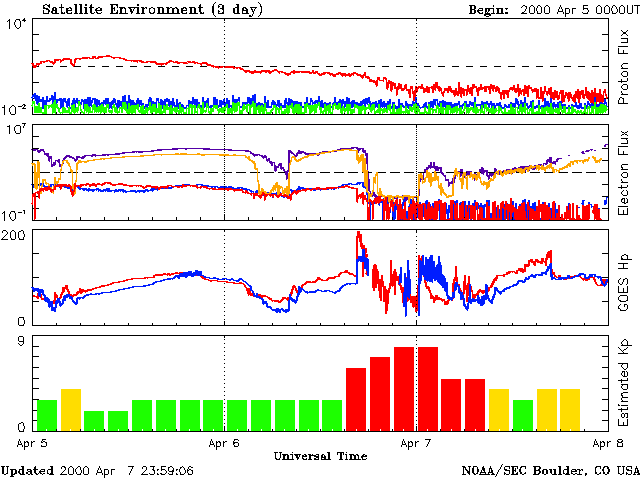
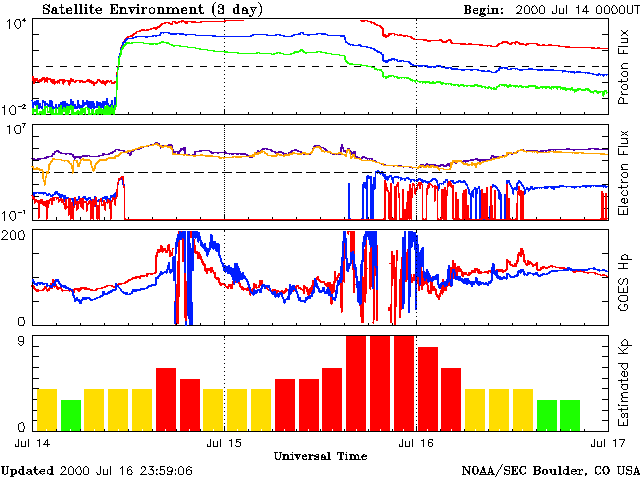

Operating on AU (from discussions with W3ZZ)

